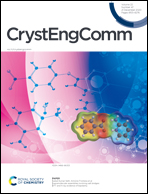Formation and phase evolution of calcium phosphates modulated by ion exchange ionomer Nafion†
Abstract
A study on the phase evolution of calcium phosphates (CaPs) in the presence of an ionomer is of great significance for understanding their intriguing behavior and applications. Nafion, as an ion exchange ionomer of perfluorosulfonic acid, could tune the formation of CaP and phase evolution due to its inherent acidity, ion exchange feature and specific morphology in solution. When the initial pH of the incubating dispersion was adjusted to 5, monetite (CaHPO4, DCPA) was obtained in the presence of Nafion; the product differs from the DCPD formed from the solution in the absence of the ionomer. Under an alkaline condition (initial pH 9), the formation of hydroxyapatite (Ca10(PO4)6·(OH)2, HAP) could be effectively tuned by Nafion; octacalcium phosphate (Ca8H2(PO4)6·5H2O, OCP) preliminarily formed in the presence of a high number of calcium ions (Ca/P = 0.2 M/0.1 M). In contrast, brushite (CaHPO4·2H2O, DCPD) was the main product with a low concentration calcium ion source (Ca/P = 0.1 M/0.2 M). Nafion plays an essential role to facilitate the deprotonation process to extend the transition for HAP formation via the DCPD dissolution–reprecipitation process. The rod-like HAP was formed by the induction of the elongated pattern Nafion with the ion exchange behavior of its side chain. The results acquired in this work not only provide a new route for the controlled preparation of CaP precursors but also help us to better understand the electrochemical behavior of CaPs assisted by Nafion.



 Please wait while we load your content...
Please wait while we load your content...